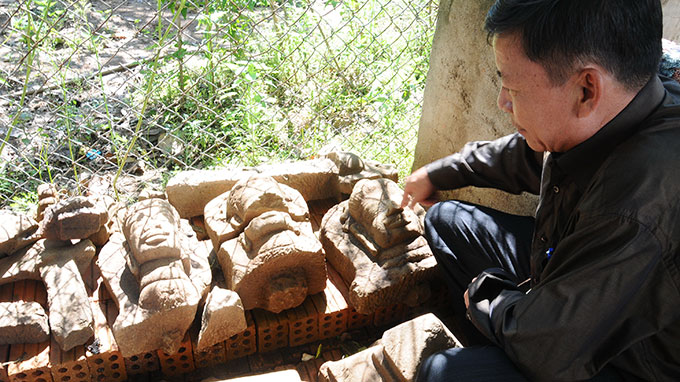Archeologists from Hanoi recently unearthed another Cham relic of great historical value in Da Nang City in central Vietnam.
After a 20-day excavation on a 1,200m2 area, archeologists from Hanoi University of Social Sciences and the Humanities uncovered a Cham tower relic in Hoa Vang District’s Hoa Phuoc Commune.
According to archeologist Nguyen Chieu, the relic boasts at least three Cham foundations dated from the late 10th century.
A sandstone perron with exquisite sculptures of a “makara” (monster), which resemble those at Khuong My Cham Tower in central Quang Nam Province’s Nui Thanh District, was also unearthed.
The archeologists also collected three statue heads and hundreds of other architectural fragments.
Chieu observed that the newly-found tower relic might have collapsed and was rebuilt.
Ha Tan Loan, vice director of Da Nang Cham Sculpture Museum, head of the excavation board, said that they’re applying for funds to develop them into new tourist spots.
Cham areas are remnants of the Kingdom of Champa (between the 7th and 18th centuries). The Cham people, or Urang Campa in the Cham language, is an ethnic group in Southeast Asia concentrated between Kampong Cham Province in Cambodia and central Vietnam's Phan Rang-Thap Cham, Phan Thiet, Ho Chi Minh City and An Giang areas.
They form the core of the Muslim communities in Cambodia and Vietnam.
According to 2008 official statistics, there are around 145,000 Cham people in Vietnam. The community ranks 14th in the country’s general population.
In a similar vein, locals in central Ha Tinh Province unearthed a valuable antique statue while renovating Ca Temple.
The statue, which remains intact, measures around 150cm in height and weighs some hundred kg.
Cast from a special kind of stone, the light yellow statue boasts distinctly, finely sculpted features.
Preliminary studies revealed that the statue is part of a set which was placed at the gateway to Ca Temple.
Built several hundreds years ago, the temple, also known as Mo Hac Linh Pagoda, worships Hoang Muoi, a court official, and river goddess named Le Thi Ngoc Dung.
After 1945, the temple shrank in size and was deserted. The structure is currently being restored.


















































